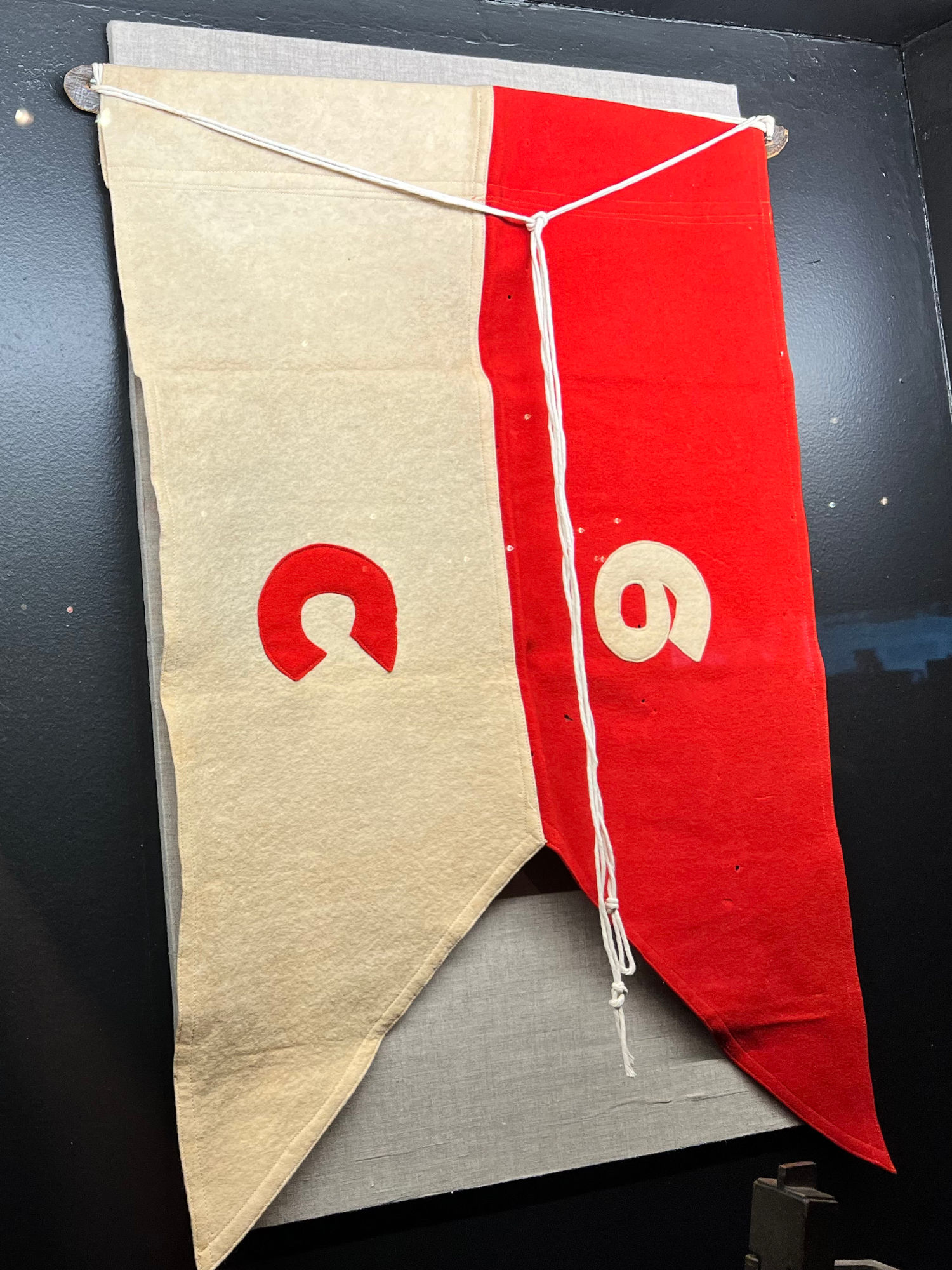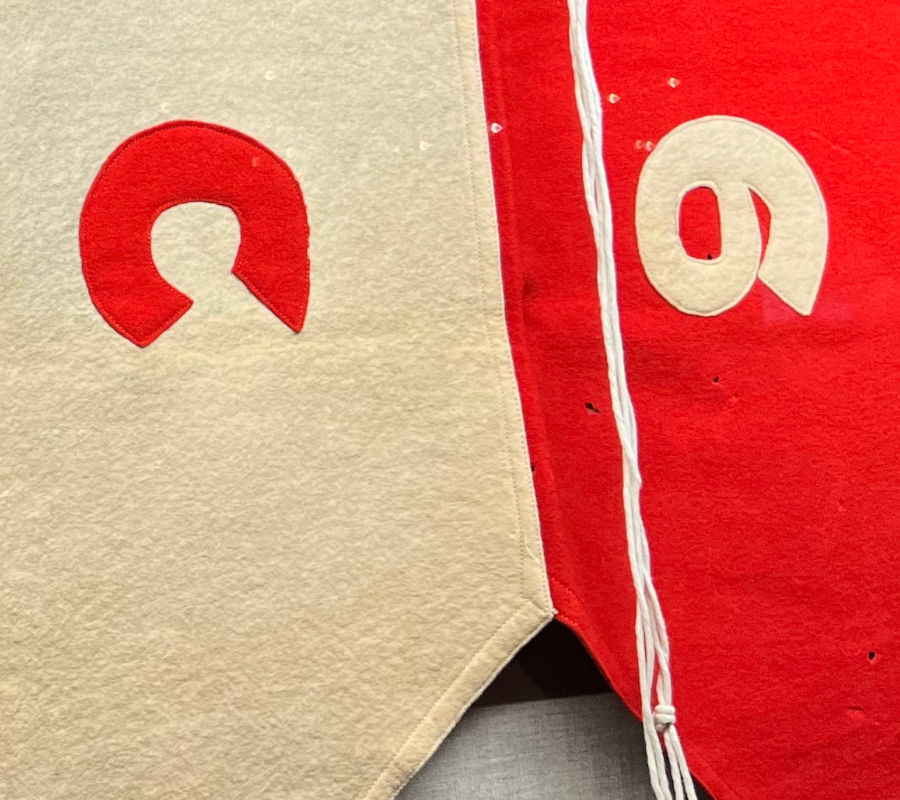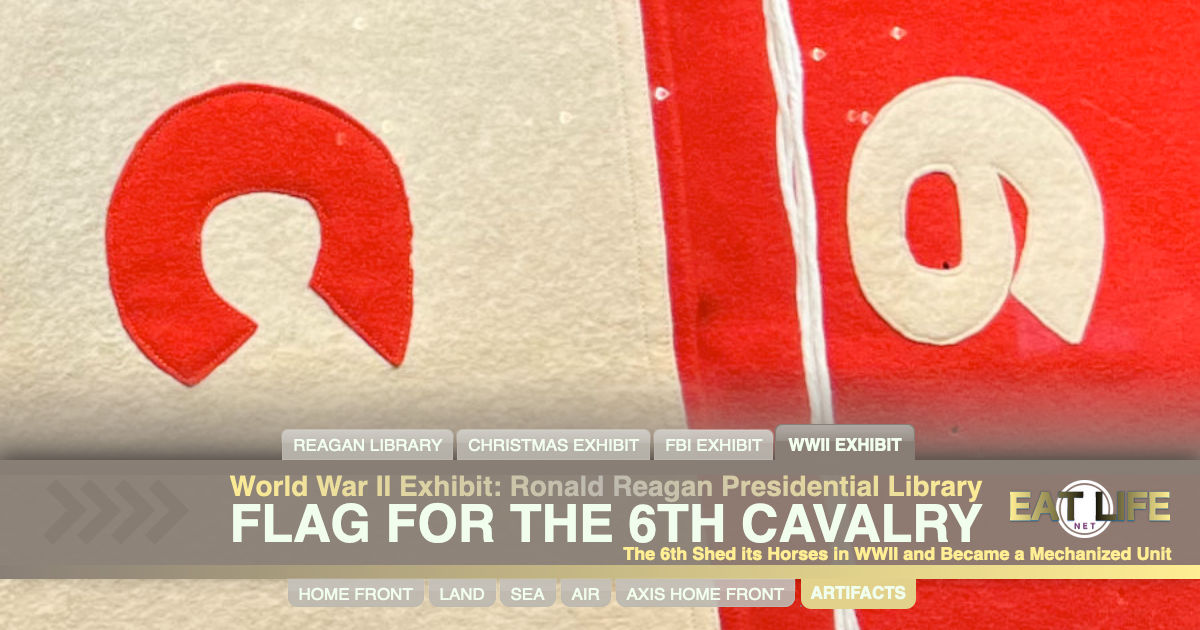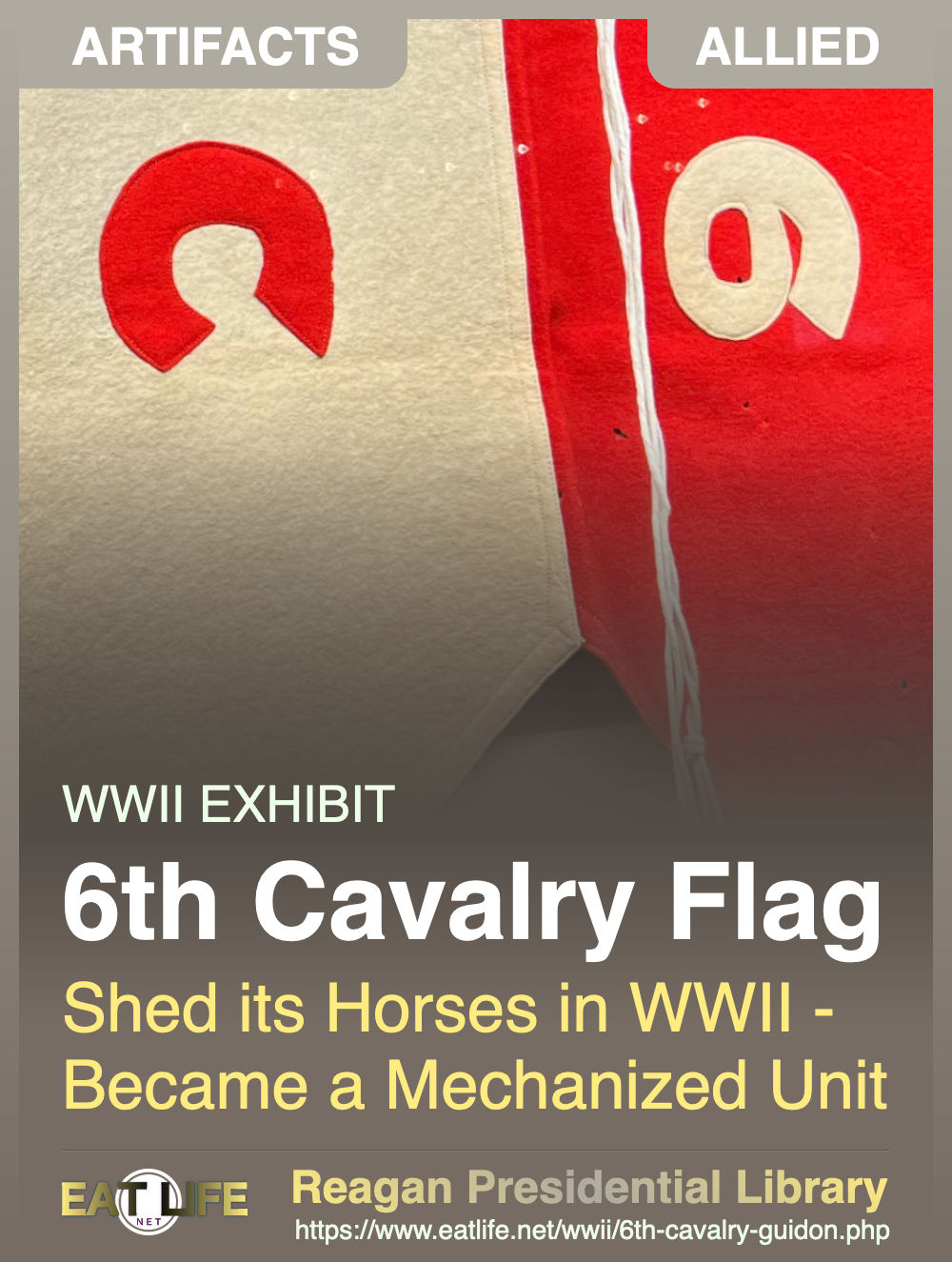
The 6th Cavalry (Mechanized) was under the command of Gen. George S. Patton
WIKIPEDIAThe 6th Cavalry
Fighting Sixth
Regiment of the United States Army that began as a regiment of cavalry in the American Civil War. It currently is organized into aviation squadrons that are assigned to several different combat aviation brigades.During the years between World War I and World War II, the 6th Cavalry participated in the Army's experiments to modernize the cavalry force and it became a "horse-mechanized regiment" with modern vehicles supported by horse trailers for operational mobility. However, once America became involved in the war after the Attack on Pearl Harbor, the 6th Cavalry shed its horses and became solely a mechanized unit. Because of this pre-war experimentation, the 6th was not broken up like many Army outfits, but retained the majority of its original personnel allowing for added stability and training continuity.
The 6th Cavalry Regiment was renamed the 6th Mechanized Cavalry Group (MCG), and was organized into two squadrons; the 6th SQDN and the 28th SQDN. The 6th MCG was assigned to General Patton's Third Army and arrived in Normandy between 9-10 July 1944. GEN Patton wanted an Army-level reconnaissance unit in order to bypass traditional reporting channels and enable quicker decision making at the field army level; this was to be called the Army Information Service (AIS), and the 6th MCG was chosen for the role.
One squadron would fulfill the duties of the AIS, while the other, in conjunction with the associated parts of the AIS squadron not needed for that role (the tank company and assault gun troop), would serve as a security force for the Army headquarters and "hip pocket" reserve for the Army Commander. The two Squadrons would rotate duties on a 21-day cycle, with a reconnaissance Troop being assigned to every Corps HQ, and platoons detached for every Division. When necessary, Sections (typically 2 Jeeps with an M8 Greyhound) could be detached down to the Regimental level.
These detachments all reported to the Squadron operations center, which directly reported up to Third Army HQ, speeding up information flow to the Army level. During Operation Cobra in 1944, the 28th SQDN (supplemented by B TRP, 6th SQDN) provided 15 detachments spread out across the 4 Corps and 11 Divisions in the Third Army, and an additional detachment to provide command and control for AIS nodes in the Brittany Peninsula. The standard time for an AIS message to go from battlefield to Army headquarters averaged two hours, twenty minutes, while the conventional channels took eight to nine hours.
Lineage
- Constituted 4 May 1861 in the Regular Army as the 3d Cavalry Regiment
- Regiment (except Companies A & B) organized 18 June 1861 at Pittsburgh, Pennsylvania.
- Company A organized June–October 1861 in Maryland and the District of Columbia
- Redesignated 3 August 1861 as the 6th Cavalry Regiment
- Company B organized 16 August 1861 at Camp Scott, Pennsylvania
- Cavalry companies officially redesignated as troops in 1883.
- Assigned 15 August 1927 to the 3d Cavalry Division, and stationed at Fort Oglethorpe, Georgia.
- A Troop consolidated 14 October 1929 with Troop D, 6th Cavalry Regiment, (organized in 1861) and consolidated unit designated as Troop A, 6th Cavalry Regiment.
- Relieved 1 December 1939 from assignment to the 3rd Cavalry Division, and moved by Road March to Fort Benning, Georgia on 11 April 1940.
- Regiment moved from Fort Benning by road 5 March May 1940 to Alexandria, Louisiana, and arrived on 8 May 1940.
- Regiment departed Alexandria, Louisiana on 27 May 1940 via Road March, and arrived at Fort Oglethorpe 30 May 1940.
- Regiment retraced their steps to Alexandria, Louisiana on 13 August 1940, and arrived 21 August 1940.
- Regiment road marched to Ragley, Louisiana on 26 July 1941, and arrived on 1 October 1941.
- Regiment road marched to Chester, South Carolina on 6 November 1941, and arrived 1 December 1941. Regiment immediately returned to Fort Oglethorpe.
- Regiment performed its last road march as a horse cavalry unit when it left Fort Oglethorpe, and moved to Camp Blanding, Florida on 18 February 1942.
- Regiment reorganized and redesignated 21 July 1942 as the 6th Cavalry Regiment, Mechanized. Troop B reorganized and redesignated as Troop E, 6th Cavalry, Mechanized.
- Regiment moved by road march to Fort Jackson on 2 November 1942.
- Regiment moved again by road march to Fort Oglethorpe on 16 April 1943.
- Regiment participated in Maneuvers at Lebanon, Tennessee from 18 April 1943 to 20 June 1943, and then road marched to Fort Jackson.
- Regiment staged at Camp Shanks, New York from 8 October 1943 until 12 October 1943, when they deployed from the New York Port of Embarkation for England.
- Regiment arrived in Tanderagee, Northern Ireland on 18 October 1943, where they prepared to reorganize for their D-Day assignment.
- Regiment broken up 1 January 1944 and its elements reorganized and redesignated as follows:
6th Cavalry Group
- Headquarters and Headquarters Troop reorganized and redesignated on 1 January 1944 as Headquarters and Headquarters Troop, 6th Cavalry Group, Mechanized with 6th and 28th Cavalry Reconnaissance Squadrons attached.
- Group landed in France on 9 July 1944, when they were assigned to the Third Army as "Patton's Household Cavalry".
- Group was recommitted to combat near St. Avold, France on 1 December 1944
- Group entered Luxembourg on 31 December 1944 to locate German forces at or near Bastogne.
- Group encountered German forces between the 26th infantry Division and 35th Infantry Division in the lintage-Saar area, where it remained until 13 January 1945.
- Group entered Germany on 25 February 1945 with VIII Corps, and attacked through Bauler, Waxweiler, and Lasel; mopped up along the Berlin Autobahn; and protected VIII Corps' southern flank.
- Group was located at Sonnenberg, Germany on 14 August 1945
- Headquarters and Headquarters Troop, 6th Cavalry Group, Mechanized, converted and redesignated 1 May 1946 as Headquarters and Headquarters Troop, 6th Constabulary Regiment.
- Redesignated 2 February 1948 as Headquarters, Headquarters and Service Troop, 6th Constabulary Regiment
- Headquarters, Headquarters and Service Troop, 6th Constabulary Regiment converted and redesignated 20 December 1948 as Headquarters and Headquarters Company, 6th Armored Cavalry Regiment. Troop A, 6th Constabulary Squadron Converted and redesignated as Company A, 6th Armored Cavalry Regiment (Former Troop D, 6th Cavalry, concurrently withdrawn from Company A, 6th Armored Cavalry – hereafter separate lineage)
6th Cavalry Reconnaissance Squadron, Mechanized
- 1st Squadron reorganized and redesignated on 1 January 1944 as the 6th Cavalry Reconnaissance Squadron, Mechanized. Troop E, 2nd Squadron, 6th Cavalry Regiment, Mechanized Reorganized and redesignated as Troop F, 6th Cavalry Reconnaissance Squadron, Mechanized. Regiment remained attached to 6th Cavalry Group, but was moved to Gilford, Northern Ireland for deployment training.
- Squadron moved to England on 13 May 1944.
- Squadron landed in France on 10 July 1944.
- Squadron entered Luxembourg on 25 December 1944.
- Squadron entered Belgium on 28 December 1944.
- Squadron entered Germany on 23 February 1945.
- Squadron was at Hildburghausen, Germany on 14 August 1945.
- 6th Cavalry Reconnaissance Squadron, Mechanized, converted and redesignated 1 May 1946 as the 6th Constabulary Squadron. Troop F converted and redesignated as Troop E, 6th Constabulary Squadron.
- 6th Constabulary Squadron, converted and redesignated 20 December 1948 as the 1st Battalion, 6th Armored Cavalry Regiment. Troop E converted and redesignated as Company B, 6th Armored Cavalry.
28th Cavalry Reconnaissance Squadron
- 2nd Squadron reorganized and redesignated on 1 January 1944 as the 28th Cavalry Reconnaissance Squadron, Mechanized. Squadron remained attached to the 6th Cavalry Group, and moved to Gilford, Northern Ireland for deployment training.
- Squadron moved to England on 13 May 1944.
- Squadron deployed to France on 10 July 1944.
- Squadron entered Luxembourg on 24 December 1944, and moved on to Belgium the same day.
- Squadron entered Germany on 24 February 1945
- Squadron was at Sonnenberg, Germany on 14 August 1945.
- 28th Cavalry Reconnaissance Squadron, Mechanized, converted and redesignated 1 May 1946 as the 28th Constabulary Squadron.
- 28th Constabulary Squadron converted and redesignated on 20 December 1948 as the 2nd Battalion, 6th Armored Cavalry Regiment.
6th Armored Cavalry Regiment
- Battalions and companies redesignated 24 June 1960 as squadrons and troops, respectively. Troop E Reorganized and redesignated as Troop B, 6th Armored Cavalry
- Regiment inactivated 24 October 1963 at Fort Knox, Kentucky
- Regiment activated 23 March 1967 at Fort George G. Meade, Maryland
- Inactivated (less 1st Squadron) 31 March 1971 at Fort George G. Meade, Maryland.
- 1st and 2nd Squadrons inactivated 21 June 1973 at Fort Bliss, Texas)
- Regiment reorganized and redesignated 22 June 1973 as the 6th Cavalry Regiment, a parent regiment under the Combat Arms Regimental System. 1st Squadron redesignated as Headquarters and Headquarters Troop, 1st Squadron, 6th Cavalry, assigned to the 1st Cavalry Division, and activated at Fort Hood, Texas (organic elements concurrently constituted and activated)
- 2nd Squadron redesignated 1 July 1974 as Headquarters and Headquarters Troop, 2d Squadron, 6th Cavalry, and activated at Fort Knox, Kentucky (organic elements concurrently constituted and activated)
- 1st Squadron relieved 21 February 1975 from assignment to the 1st Cavalry Division.
- Regiment withdrawn 1986 from the Combat Arms Regimental System and reorganized under the United States Army Regimental System.
- 2nd Squadron inactivated 30 May 1986 at Fort Knox, Kentucky
- 2nd Squadron activated 16 July 1986 at Fort Hood, Texas
- 1st Squadron inactivated 15 December 1995 at Fort Hood, Texas
- 1st Squadron activated 16 July 1996 in Korea
- 3rd Squadron departed Fort Hood, Texas and arrived at Camp Humphreys, near Pyongtaek in Korea, July 1996. 3rd Squadron was honored by maintaining the Regimental Colors until they were deactivated.
- 3rd Squadron inactivated and reflagged as the 4th Battalion, 2d Aviation Regiment in Korea








